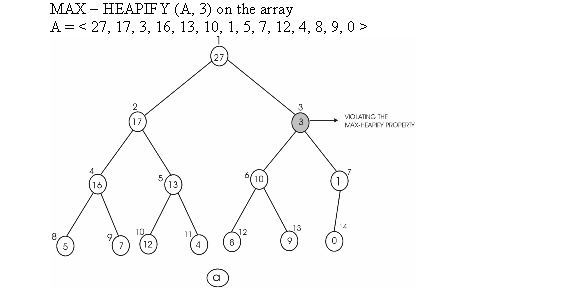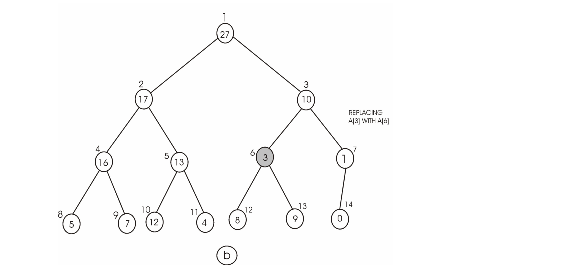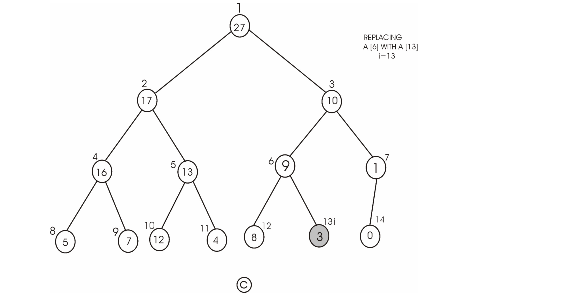Min-Heap
The order of elements in the min-heap is different to the order of elements in the max-heap. In the max-heap, the element of the root should be greater than or equal to the elements of its children. In the min-heap, the element of the root should be less than or equal to the elements of its children.
The procedure of MIN-HEAPIFY is similar to the procedure of MAX-HEAPIFY, except in some conditions. The procedure of MIN-HEAPIFY is as follows:

1 
2 
3 if  and
and

4 
5 else 
6 if  and
and

7 
8 if 
9 exchange  with
with

10 
The following steps are changed in the MIN-HEAPIFY procedure, when compared to the MAX-HEAPIFY procedure.
The heading  is changed
to
is changed
to 
The variable largest is changed to least.
In line 3, the condition  is changed
to
is changed
to 
In line 6, the condition  is changed
to
is changed
to 
In line 9, the value  is changed
to
is changed
to 
In line 10, the call  is changed
to
is changed
to 
There are no other changes in the loops or procedure. So, the
running time of MIN-HEAPIFY procedure is the same as the running
time of MAX-HEAPIFY procedure. Therefore, the running time of
MIN-HEAPIFY procedure is  .
.
MAX–HEAPIFY does not cause any changes to the heap tree
for .
.
When , the node
is a leaf node. It does not have any left or right children.
, the node
is a leaf node. It does not have any left or right children.
Hence, there will not be any change in the heap tree.
Example: Consider the following heap tree.

In this max–heap,  . Then
. Then

For , i
will be 4, 5, 6. The nodes at 4, 5 ,6 do not contain any left or
right sub trees or children.
, i
will be 4, 5, 6. The nodes at 4, 5 ,6 do not contain any left or
right sub trees or children.
Hence, MAX – HEAPIFY does not cause any effect.
Following is the modified MAX-HEAPIFY procedure using iterative control structure:
Iterative-MAX-HEAPIFY (A, i)
// Execute the loop while true
1. while (true)
// Assign the node LEFT(i) to left
2. left = LEFT(i)
// Assign the node RIGHT(i)to right
3. right = RIGHT(i)
// Check whether left  A.heap-size
and A[left] > A[i].
A.heap-size
and A[left] > A[i].
// If true then assign left to largest.
//If false then assign index i to largest.
4. if left  A.heap-size
and A[left] > A[i]
A.heap-size
and A[left] > A[i]
5. largest = left
6. else
7. largest = i
// Check whether r A.heap-size
and A[r]>A[largest]
A.heap-size
and A[r]>A[largest]
// If true then assign r to largest.
8. if r  A.heap-size
and A[r] > A[largest]
A.heap-size
and A[r] > A[largest]
9. largest = r
// Check whether i is equal to largest.
// If false then swap A[i] and A[largest].
10. if largest  i
i
11. Exchange A[i] with A[Largest]
12. if largest = i
13. break
// Assign largest to i
14. i = largest







